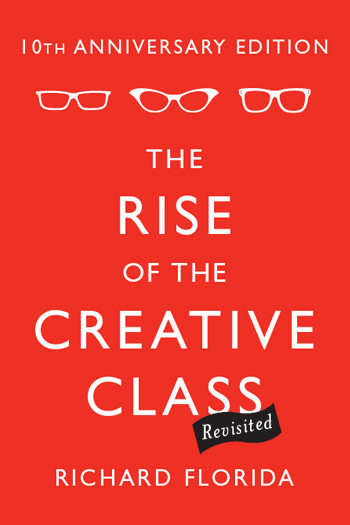
Excerpted with permission from The Rise of the Creative Class Revisited: 10th Anniversary Edition, by Richard Florida. Available from Basic Books, a member of The Perseus Books Group. Copyright (C) 2012.

Four years after the great economic and financial crash of 2008, the U.S. economy continues to sputter and Europe teeters on the brink of economic collapse. Even China appears to be slowing down. Only one advanced nation has been able to rebound to pre-crisis levels of jobs and economic output: Canada.
While policy makers and pundits around the world debate the merits of various short-term fixes -- tax cuts versus stimulus, budget cuts versus monetary easing -- they miss the bigger point, one which I describe in detail in my just-published The Rise of the Creative Class, Revisited. We are living through a massive structural transformation of the economy, similar in scale and scope to the shift from the Agricultural to the Industrial Age. As such, it dwarfs even the Great Depression of the 1930s.
Canada is shifting from the Industrial to the Creative Age, in which creativity, "the ability to create meaningful new forms," as The Random House Webster's Dictionary puts it, has become the decisive source of competitive advantage.

The chart above reveals the depth of this transformation. Based on research by my team at the Martin Prosperity Institute, it tracks Canadian employment from 1900 to 2000. As you can see, the share of Agriculture jobs began to decline precipitously at the beginning of the last century. The past couple of decades have been distinguished by another massive shift: this time from the Industrial to the Creative Age.
Canada entered the Industrial Age in the early part of the 20th century when farming, which once made up more than half of Canada's workforce, began its long decline. The Working Class (35 per cent share of total employment) surpassed Farming (31 per cent) by the 1930s. Farming slipped to just five per cent of employment in 1980 and has fallen even lower today. The Working Class, which accounted for roughly 40 per cent of Canadian employment for most of the 20th century, began to slip in the 1980s and now accounts for about one in four or five of Canadian workers.
The Creative Age is distinguished by the rise of two great social classes. The first is the Creative Class -- workers in science and technology, arts, culture and entertainment, and professional knowledge workers in healthcare, law and management. This epoch-defining class comprised less than five per cent of the workforce at the turn of the 20th century, growing to 31 per cent by mid-century, before surging in the 1980s. Today, five million Canadian workers are members of the Creative Class, roughly thirty per cent of the workforce.
The second, and larger of the two classes, is the Service Class, whose members prepare and serve food, carry out routine clerical and administrative tasks, provide home and personal health assistance, do janitorial work, and the like. Its ranks surged from approximately one quarter of Canada's workforce in 1960 to almost eight million today, roughly half of Canada's workforce.
Service Class workers who work full-time earned just 60 per cent of the average wages paid to the Creative Class -- $46,129 per year compared to $75,199. And, the Service Class is disproportionately concentrated among at risk groups -- recent immigrants, high school drop-outs, aboriginals and single parents -- who earn even less. Single parents take home just three-quarters of the average Service Class wage; recent immigrants just two-thirds.
Though Canada has been astonishingly resilient through the crisis -- it is the only advanced nation where economic output and employment top pre-crisis levels -- the key to sustainable prosperity lies in developing strategies and making investments that can speed the transition to the new Creative Age. That means removing the central props that continue to hold up the old economy -- the incentives and subsidies that keep the badly broken housing-auto-energy economy breathing.
It also means bringing more Canadian workers into the orbit of creativity. The way to do this is to essentially creatify their work. Our MPI research shows that the addition of creative skills to service and manufacturing work boosts wages at an even higher rate than when it's added to Creative Class work.
While we sometimes forget this, the blue-collar jobs that we so pine for today weren't always good family supporting jobs. William Blake aptly dubbed factories "Satanic mills," and for much of the Industrial Age, the work was low-pay, dirty and dangerous -- what Marx said would lead the proletariat to revolt. The post World War II era saw the establishment of a social compact between labour and capital that turned these formerly bad jobs into good ones. Unions helped to forge this and wages rose in tandem with productivity. Much of the blue-collar manufacturing work that remains in Canada is already creative work, tapping workers' intelligence, creativity and skill as a source of continuous productivity improvement.
The last frontier of work-upgrading lies with the Service Class, the largest class in terms of sheer numbers. Upgrading service work is not only good for the workers who do this kind of work, It can provide a much needed boost to the economy as a whole, increasing purchasing power and stimulating demand (as was the case with higher-paying blue-collar jobs in the 1950s and 1960s). Yes, it is true that we will all have to share the cost of higher-paid service work, just as we paid more for cars and manufactured goods after World War II. The burden of long-run prosperity is one we all have to share.
To get there, a new social compact is needed, one that invests in the creativity of every single human being in order to upgrade and generate new higher-paying jobs, address the gross inequities in our economy and society, and lay the institutional foundations for a new era of shared prosperity.
Richard Florida is author of The Rise of the Creative Class Revisited released by Basic Books on June 26th. He is Director of the Martin Prosperity Institute at the University of Toronto'sRotman School of Management.